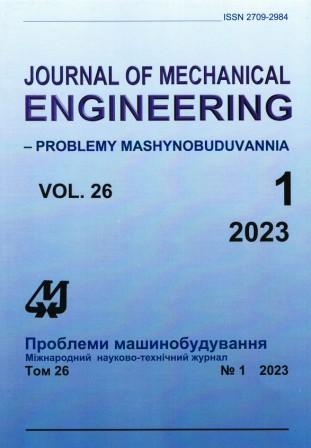Аеропружні властивості робочих лопаток останнього ступеня потужної парової турбіни
Аннотация
Лопатки потужних парових турбін зазнають значних нестаціонарних навантажень, які, у деяких випадках, можуть призвести до появи самозбудних коливань або автоколивань. Ці коливання вкрай небезпечні та негативно впливають на ресурс лопаткового апарату. При розробці нових чи модернізації існуючих ступенів турбіни необхідно виконувати дослідження аеропружної поведінки робочих лопаток. В результаті модернізації циліндру низького тиску парової турбіни 1000 МВт довжина робочих лопаток останнього ступеня збільшилась до 1650 мм. У зв’язку з цим було проведено чисельний аналіз аеропружних характеристик робочих лопаток останнього ступеня у номінальному режимі роботи. При аналізі використовувався метод розв’язання зв’язаної задачі нестаціонарної аеродинаміки та пружних коливань лопаток, який дозволяє прогнозувати амплітудно-частотний спектр нестаціонарних навантажень і коливань лопаток в потоці в’язкого газу. У роботі представлено результати чисельного аналізу аеропружних характеристик лопаткового вінця ротора останнього ступеня як для режиму вимушених гармонійних коливань з заданою амплітудою та міжлопатковим зсувом фаз, так і для режиму зв’язаних коливань лопаток під дією нестаціонарних аеродинамічних сил. Результати моделювання зв’язаних коливань лопаток для п’яти перших власних форм представлено у формі розподілу за часом переміщення периферійного перетину лопатки, а також сил та моментів, що діють на периферійний перетин. Наведено також відповідні амплітудно-частотні спектри переміщень та навантажень у периферійному перетині. Результати розрахунків показали позитивне демпфування коливань, відсутність флатеру та автоколивань на перших п’яти власних формах коливань лопатки у номінальному режимі роботи парової турбіни.
Загрузки
Опубликован
Выпуск
Раздел
Лицензия
Copyright (c) 2023 Л. В. Колодяжна, Ю. А. Биков

Это произведение доступно по лицензии Creative Commons «Attribution-NoDerivatives» («Атрибуция — Без производных произведений») 4.0 Всемирная.
Авторы, публикующиеся в этом журнале, соглашаются со следующими условиями:
- Авторы оставляют за собой право на авторство своей работы и передают журналу право первой публикации этой работы на условиях лицензионного договора (соглашения).
- Авторы имеют право заключать самостоятельно дополнительные договора (соглашения) о неэксклюзивном распространении работы в том виде, в котором она была опубликована этим журналом (например, размещать работу в электронном хранилище учреждения или публиковать в составе монографии), при условии сохранения ссылки на первую публикацию работы в этом журнале.
- Политика журнала позволяет размещение авторами в сети Интернет (например, в хранилищах учреждения или на персональных веб-сайтах) рукописи работы, как до подачи этой рукописи в редакцию, так и во время ее редакционной обработки, поскольку это способствует возникновению продуктивной научной дискуссии и позитивно отражается на оперативности и динамике цитирования опубликованной работы (см. The Effect of Open Access).

